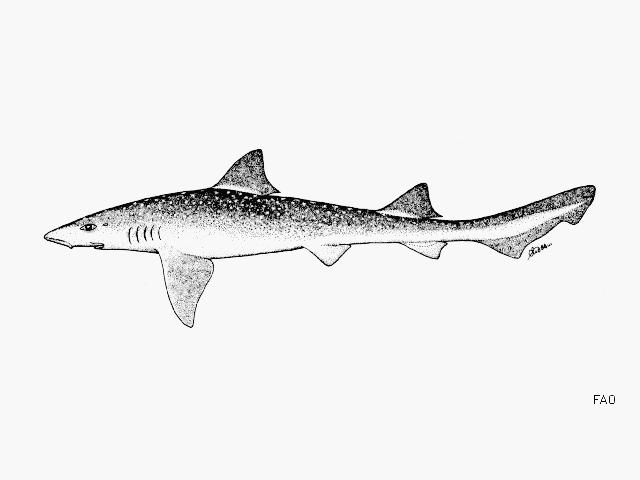Mustelus lenticulatus
Phillipps, 1932
Spotted estuary smooth-hound
Classification: Elasmobranchii Carcharhiniformes Triakidae
Reference of the original description
Notes on new fishes from New Zealand. New Zealand Journal of Science and Technology, 13(4), 226–234
Notes on new fishes from New Zealand. New Zealand Journal of Science and Technology, 13(4), 226–234
Synonyms / new combinations and misspellings
Cynias lenticulatus
Cynias lenticulatus
Description :
Citation: Mustelus lenticulatus Phillipps, 1932: In: Database of modern sharks, rays and chimaeras, www.shark-references.com, World Wide Web electronic publication, Version 01/2026
Please send your images of "Mustelus lenticulatus" to info@shark-references.com

Mustelus lenticulatus Phillipps, 1932, © FAO, www.fish-base.org

Mustelus lenticulatus Phillipps, 1932, © FAO, www.fish-base.org
Common names
 Musola manchada,
Musola manchada,  Emissole grivelée,
Emissole grivelée,  Gummy shark,
Gummy shark,  Rig,
Rig,  Smooth-hound,
Smooth-hound,  Spotted dogfish,
Spotted dogfish,  Spotted estuary rig,
Spotted estuary rig,  Spotted estuary smooth hound,
Spotted estuary smooth hound,  Spotted estuary smooth-hound,
Spotted estuary smooth-hound,  Spotted smoothhound
Spotted smoothhound
 Musola manchada,
Musola manchada,  Emissole grivelée,
Emissole grivelée,  Gummy shark,
Gummy shark,  Rig,
Rig,  Smooth-hound,
Smooth-hound,  Spotted dogfish,
Spotted dogfish,  Spotted estuary rig,
Spotted estuary rig,  Spotted estuary smooth hound,
Spotted estuary smooth hound,  Spotted estuary smooth-hound,
Spotted estuary smooth-hound,  Spotted smoothhound
Spotted smoothhound
Short Description
Diagnosis after Compagno, 1984 [517]: Body fairly slender. Head short, prepectoral length 17 to 21% of total length; snout moderately long and bluntly angular in lateral view, preoral snout 5.9 to 7.3% of total length, preorbital snout 6.6 to 8.2% of total length; internarial space moderate, 2.4 to 2.9% of total length; eyes fairly large, eye length 1.8 to 3.2 times in preorbital snout and 2.4 to 4.4% of total length; interorbital space fairly broad, 4.1 to 5.2% of total length; mouth short, subequal to eye length and 2.6 to 3.5% of total length; upper labial furrows considerably longer than lowers, upper furrows 1.9 to 2.9% of total length; teeth molariform and asymmetric, with cusp reduced to a low point; condition of buccopharyngeal denticles unknown. Interdorsal space 18 to 24% of total length; trailing edges of dorsal fins denticulate, without bare ceratotrichia; first dorsal broadly triangular, with posteroventrally sloping posterior margin, its midbase closer to pelvic bases than to pectorals; pectoral fins fairly large and broad, length of anterior margins 12 to 16% of total length, width of posterior margin 8.7 to 17% of total length; pelvic fins moderately large, anterior margin length 7.2 to 8.7% of total length; anal height 2.7 to 4.3% of total length; anal-caudal space somewhat greater than second dorsal height, 6.5 to 8.7% of total length; ventral caudal lobe not strongly falcate in adults. Crowns of lateral trunk denticles lanceolate, with longitudinal ridges possibly extending their entire length. Skeleton not hypercalcified in adults; palatoquadrates not subdivided; monospondylous precaudal centra 35 to 41, diplospondylous precaudal centra 50 to 56, precaudal centra 87 to 95. Colour grey or grey-brown, above, light below, usually with numerous white spots but lacking dark spots or dark bars. Development ovoviviparous. Size large, adults 78 to 137 cm.
Diagnosis after Compagno, 1984 [517]: Body fairly slender. Head short, prepectoral length 17 to 21% of total length; snout moderately long and bluntly angular in lateral view, preoral snout 5.9 to 7.3% of total length, preorbital snout 6.6 to 8.2% of total length; internarial space moderate, 2.4 to 2.9% of total length; eyes fairly large, eye length 1.8 to 3.2 times in preorbital snout and 2.4 to 4.4% of total length; interorbital space fairly broad, 4.1 to 5.2% of total length; mouth short, subequal to eye length and 2.6 to 3.5% of total length; upper labial furrows considerably longer than lowers, upper furrows 1.9 to 2.9% of total length; teeth molariform and asymmetric, with cusp reduced to a low point; condition of buccopharyngeal denticles unknown. Interdorsal space 18 to 24% of total length; trailing edges of dorsal fins denticulate, without bare ceratotrichia; first dorsal broadly triangular, with posteroventrally sloping posterior margin, its midbase closer to pelvic bases than to pectorals; pectoral fins fairly large and broad, length of anterior margins 12 to 16% of total length, width of posterior margin 8.7 to 17% of total length; pelvic fins moderately large, anterior margin length 7.2 to 8.7% of total length; anal height 2.7 to 4.3% of total length; anal-caudal space somewhat greater than second dorsal height, 6.5 to 8.7% of total length; ventral caudal lobe not strongly falcate in adults. Crowns of lateral trunk denticles lanceolate, with longitudinal ridges possibly extending their entire length. Skeleton not hypercalcified in adults; palatoquadrates not subdivided; monospondylous precaudal centra 35 to 41, diplospondylous precaudal centra 50 to 56, precaudal centra 87 to 95. Colour grey or grey-brown, above, light below, usually with numerous white spots but lacking dark spots or dark bars. Development ovoviviparous. Size large, adults 78 to 137 cm.
Distribution
Southwest Pacific: Kermadec Islands (Ref. 8879) and New Zealand; reported from southern Australia (Ref. 9258). Source: www.gbif.org
Southwest Pacific: Kermadec Islands (Ref. 8879) and New Zealand; reported from southern Australia (Ref. 9258). Source: www.gbif.org
Human uses
fisheries: commercial; gamefish: yes
fisheries: commercial; gamefish: yes
Biology
Ovoviviparous, embryos feed solely on yolk [733]. With 2 to 37 young born at 20-32 cm [578].
Ovoviviparous, embryos feed solely on yolk [733]. With 2 to 37 young born at 20-32 cm [578].
Remarks
shark-references Species-ID=3801;
shark-references Species-ID=3801;
Parasites (arranged by Jürgen Pollerspöck)
Cestoda
Cestoda
- Calliobothrium tylotocephalum Alexander, 1963 [16245]
- Calliobothrium verticillatum (Rudolphi, 1819) [16245]
- Coronocestus coronatus (Robinson, 1959) [16384] [16245] [16430] [19536]
- Phyllobothrium lactuca Van Beneden, 1850 [16245] [16443]
- Symcallio eschrichti (Van Beneden, 1850) [16245]
- Symcallio schneiderae (Pickering & Caira, 2008) [16106] [21796]
















